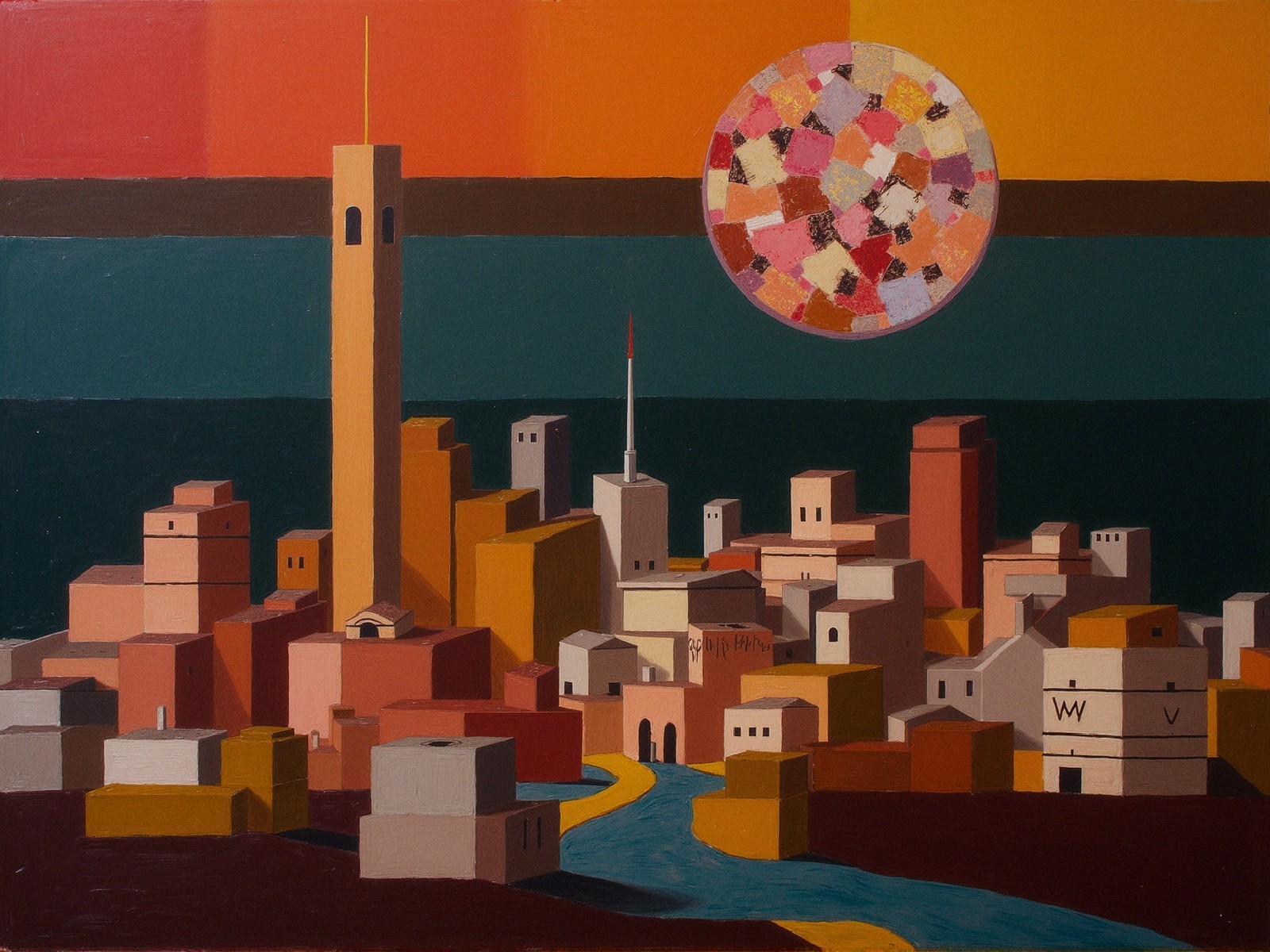Prompt:
### **1. Background and Sky**
The upper portion of the painting is divided into horizontal bands, creating a layered sky:
- **Topmost Band**: A gradient of *vibrant red* (ranging from bright crimson to deep maroon) suggests a sunset or sunrise, evoking warmth and transition.
- **Middle Band**: A narrow, *dark, muted brown* stripe separates the red sky from the lower section, acting as a horizon or cloud layer.
- **Lower Sky**: A broad expanse of *muted teal or olive-green* dominates the middle ground, rendered with subtle textural variations (visible brushstrokes) to imply depth and twilight. The color shifts from darker tones near the horizon to slightly lighter hues as it ascends, enhancing the sense of atmospheric perspective.
### **2. Celestial Body (Sun/Moon)**
Positioned in the *upper right quadrant*, a large circular form represents the sun or moon. Unlike a solid shape, it is filled with a **mosaic of small, irregular geometric fragments** (squares, rectangles, and interlocking patterns) in *warm hues*: fiery oranges, golden yellows, soft pinks, and hints of purple. This intricate patchwork gives the celestial body a textured, almost quilted appearance, contrasting sharply with the smooth, dark sky and drawing the viewer’s eye as a focal point.
### **3. Abstract Cityscape (Foreground)**
The city is constructed from **geometric shapes** (rectangles, squares, triangles) stacked and interlocked to form a fragmented skyline. Key details:
- **Color Palette**: Warm, earthy tones dominate—*reds, oranges, browns, beiges, and whites*—with occasional grays for contrast. These colors evoke energy and life, contrasting the cool sky.
- **Structure**: Buildings lack realistic details (no windows, doors, or textures). Instead, they are *blocky, overlapping forms*:
- Taller structures (e.g., a rectangular tower on the left, a narrow orange tower on the right) pierce the skyline.
- Shorter, clustered shapes create density, with some forms featuring *zigzag lines* (e.g., a stylized “M” shape at the center) that suggest abstract architectural details.
- **Base**: The city rests on a *dark, rich maroon or deep brown* ground, implying an elevated hill or solid foundation. This dark base anchors the composition and contrasts with the lighter city forms above.
### **4. Style, Mood, and Symbolism**
- **Artistic Influences**: The work echoes early 20th-century movements like **Cubism** (fragmented forms, multiple perspectives) and **Suprematism** (geometric abstraction, emphasis on shape over realism). The city’s blocky shapes and the sun’s mosaic pattern reflect a rejection of naturalism in favor of symbolic representation.
- **Mood**: Ethereal and contemplative—the warm city contrasts with the cool, dark sky, creating tension between vitality (the city) and mystery (the twilight). The abstract forms evoke nostalgia or a utopian vision, as if depicting a city of the mind rather than reality.
- **Visual Harmony**: The geometric patterns in the sun mirror the city’s fragmented shapes, unifying the composition. The red sky’s warmth echoes the city’s colors, while the cool green sky provides a serene backdrop.
### **5. Subtle Details**
- A *thin blue line* at the very bottom hints at a distant horizon or base, adding a final layer of depth.

 Artist
Artist